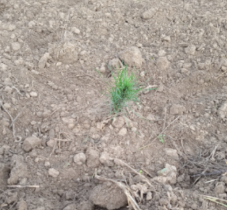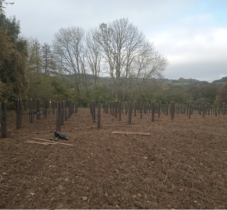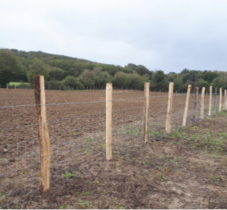Project description
Take part in the restoration of these abandoned farms and planting of hedgerows in the Sarthe with Reforest'Action !
The project at a glance
- Number of trees to be planted: 2,058
- Plantation area: 1.07 hectares
- Species planted: sessile oak, hairy oak, black pine, basswood, Douglas fir, field maple, warty birch, common hornbeam, pedunculate oak, cherry, black cherry, common holly, chestnut
- Project type: planting of a neglected farmland and planting of hedgerows
- Season of plantation: November 2022
- Region : Pays de la Loire
- Certification : None
The origin of the project
Located in the department of Sarthe, in the town of Vernie, this project aims to afforest an agricultural wasteland through the planting of 2,058 trees of 14 different species. The diversity of species chosen is intended to make the forest more resilient to potential climatic hazards, to develop the diversity of the area in terms of landscapes and to promote the development of a rich and varied biodiversity.
The trees planted will help improve soil fertility and contribute to the fight against climate change through carbon storage.
Generated benefits
-
Fight against climate change: trees provide fruit, fodder, wood, resins, tannins etc. Once planted, they regulate temperatures through the shade of their foliage. Carbon sinks, they store CO₂ and are valuable allies in the fight against global warming. They restore soil fertility and prevent soil erosion.
-
Development of biodiversity: agroforestry promotes biodiversity and provides multiple habitats and species. Micro-organisms, fauna, and flora participate in the restoration of an ecological network. They provide refuges for birds that regulate pest populations on crops.
-
Protection of territories: the planting of trees in agroforestry helps to protect the land from extreme weather events. By creating shaded areas, the trees preserve the crops during the dry season and provide them with a protective cover during the rainy season.
-
Soil enrichment: the leaves fallen from the trees will allow the creation of organic matter that will enrich the soils and contribute to the proper functioning of the forest ecosystem.
-
Wood supply: eventually, some mature trees may be harvested to supply the timber industry, economic lung that needs to operate a sustainable energy transition.
-
Soil nutrition: trees retain rainwater on the soil surface and filter it before it enters the water table. Thus, forest canopies regulate the water cycle and help preserve the planet's water resources.





